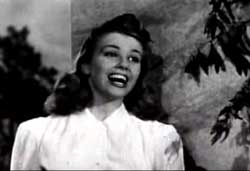 Sixteen year old Doris Day sings for Les Brown & His Orchestra in the soundie My Lost Horizon (1941), her first film appearance.
Sixteen year old Doris Day sings for Les Brown & His Orchestra in the soundie My Lost Horizon (1941), her first film appearance.
It opens with a ballroom dance couple & Les Brown's orchestration. Les is in the background with his saxophone, & the band members are dressed casual.
Jump-cut to the beautiful young face of Doris with a shouilder-length girl-next-door hairdo & amazingly cute little curl of a forelock.
She's singing: "You're like some far off lost horizon" & further lyrics of romantic gush.
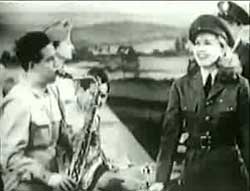 The Les Brown orchestra is just about always pap in the ealry 40s, & they got pretty lame by the 1960s; their prime was the early '50s. The Les Brown orchestra is just about always pap in the ealry 40s, & they got pretty lame by the 1960s; their prime was the early '50s.
Really nothing distinguishes this sleepy arrangement. It is strictly the youthful beauty of Doris Day setting it apart from the usual.
Doris Day also sings the wartime swing hit Is It Love or Is It Conscription? (1941) for Les & His Orchestra.
She, Les, & the whole band are dressed in military uniforms. The lyrics begin: "Is it love or is it conscription?/ Is this marriage epidemic fact or fiction?"
It's a number about her preparing to wed, as so many did immediately before parting to go to war. It's not much of a song to tell the truth, but meaninful for its day.
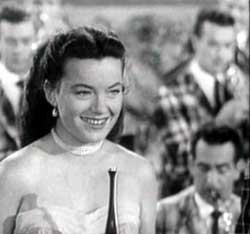 Les Brown & His Orchestra backs up Lucy Ann Polk on the Snader telescription I've Got the World on a String (1951).
Les Brown & His Orchestra backs up Lucy Ann Polk on the Snader telescription I've Got the World on a String (1951).
Les with his curly shock of hair & his plaid suit appears sweetly tacky leading the boys, who wear ugly-ass jackets to match Les's. The set is arranged to look like a rooftop overlooking city, a backdrop a painting.
There's a trumbone solo followed by an alto sax solo, then Les saunters stage right to grab Lucy Ann by the hand & lead her center stage to sing:
"I've got the world on a string/ Sittin' on a rainbow/ Got the string around my finger/ What a world, what a life, I'm in love..." Lucy Ann's perky, cute as a button, & sings this standard very nicely.
She dances cheek to cheek with Les at a quick instrumental break, then back to the microphone for her close. This is a lovely performance, & always bare in mind that Snaders are authentic live performances, unlike the soundies that had the music recorded just prior to filming.
The year of this recording, Lucy Ann Polk won her first of many Downbeat Awards for Best Girl Singer with a Band. She did her best work with Les Brown, but also sang for Kay Kyser & Tommy Dorsey, among others.
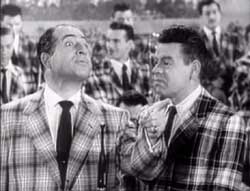 For Time Will Take Care of Everything (1951) has Les Brown & His Orchestra on the same staged rooftop set in their plaid jackets -- all the telescriptions having been made in one day on one set.
For Time Will Take Care of Everything (1951) has Les Brown & His Orchestra on the same staged rooftop set in their plaid jackets -- all the telescriptions having been made in one day on one set.
Les starts the band up with a lot of vigor, then takes the microphone for an introduction, "Ladies & gentlemen, here's a boy in the band, originally had a little trouble. Here's Butch Stone to tell you all about it. Come here Henry!"
Butch begins his vocal with a highly upbeat jump-jazz aggression: "When I first met ya, you din't have a pot/ You know I'm responsible for everything you got/ You were square as a city block, & dumb too/ And then I hipped ya, you turned to somebody new/ Well time takes care of everything/ Time'll take care of you..."
The lyrics continue with great & cruel humor, then up comes a fine alto sax solo before Butch's final verse. This number was re-recorded a few years later by Lou Rawls who made it a hit all over again.
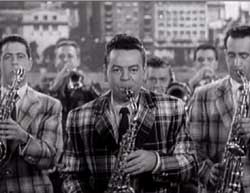 Les wasn't one to hog the limelight. He conducted & let his boys shine. But for Billboard March (1951) he takes up saxophone himself, & joins the group sax opening. He'll soon puts his sax aside, well before there's a big sax solo for one of the boys. Electric guitar & drum get highlighted, then a piano solo. Les wasn't one to hog the limelight. He conducted & let his boys shine. But for Billboard March (1951) he takes up saxophone himself, & joins the group sax opening. He'll soon puts his sax aside, well before there's a big sax solo for one of the boys. Electric guitar & drum get highlighted, then a piano solo.
It's loud & lively to the end, a true march suitable for a parade. And if you listen to the piece closely you'll recognize a couple familiar old songs worked into the march.
Les Brown & His Orchestra was at its peak of excellence in the early fifties, & the Snader telescriptions capture him at his best. He was on the verge of adapting the name Les Brown & the Band of Renowns, but are still called "and his orchestra" in the telescribed Dance of Renown (1952).
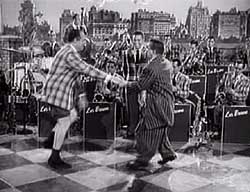 Although this wee film carries a copyright date later than the other telescriptions, it was actually filmed the same time as the others, on the familiar rooftop with Les still in his plaid looking a mite Spike Jonesish. Although this wee film carries a copyright date later than the other telescriptions, it was actually filmed the same time as the others, on the familiar rooftop with Les still in his plaid looking a mite Spike Jonesish.
The instrumental has a jump-jive beat suited for jitterbugging. It begins with a piano solo, passed to a lead guitarist, while we see Butch Stone stamping his feet & clapping his hands seated in front of the bass drum.
Butch is so excited & wiggling so hard that Les asks, "Hey Butch, care to dance?" "Love to!" Butch jumps up & grabs Les to start dancing. "No, Butch! Not with me, my kid brother Stumpy. Stumpy!"
Out comes Stumpy Brown, a short plump fellow with crewcut & glasses, in striped jacket & pants, dancing on one leg, then on both, then pulling his trousers up to his chest, & pulling his wide flowery tie out of his pants so that his tie hangs to his crotch.
As he he dances in place, Butch saschets over to join in the comedy routine, having pulled his trouser legs up to reveal his legs & knees. They end up doing a delightful boogie woogie together. The music is excellent fun & the dancing is a riot.
copyright © by Paghat the Ratgirl
|
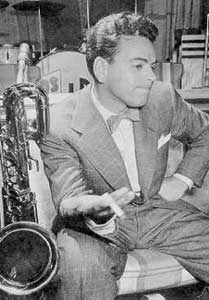

 The Les Brown orchestra is just about always pap in the ealry 40s, & they got pretty lame by the 1960s; their prime was the early '50s.
The Les Brown orchestra is just about always pap in the ealry 40s, & they got pretty lame by the 1960s; their prime was the early '50s.


 Although this wee film carries a copyright date later than the other telescriptions, it was actually filmed the same time as the others, on the familiar rooftop with Les still in his plaid looking a mite Spike Jonesish.
Although this wee film carries a copyright date later than the other telescriptions, it was actually filmed the same time as the others, on the familiar rooftop with Les still in his plaid looking a mite Spike Jonesish.